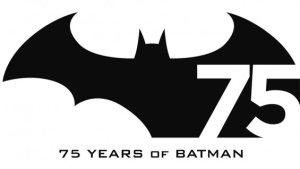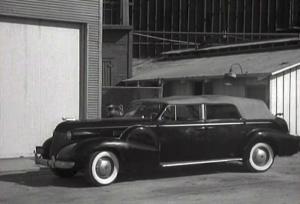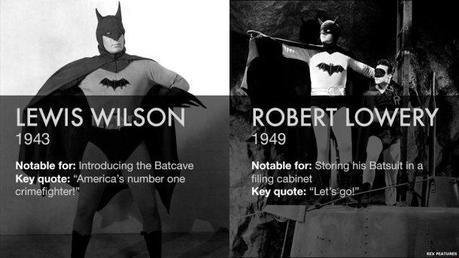2014 is the 75 year anniversary of Batman’s first appearance in the comics! So, we’re doing a series of articles (called “Batman 75“-blunt, and to the point, right?) looking back at the Caped Crusader’s history as well as articles covering DC’s efforts to celebrate the anniversary.

Before there were TV shows (or even TVs in general) there were film serials, which were like extra-long films broken up into (normally) 12 chapters or episodes, almost all of which ended on a cliffhanger. Peaking in popularity between 1936 and 1945, these serials were often aimed at younger audiences, individual episodes playing for an entire week at theaters, packaged with newsreels, cartoons, and/or feature-length films. Audiences had to keep coming back each week to see how the heroes would get out of their latest crazy predicament or how the story ultimately ended [spoiler: the good guys always won].
Of course, consuming a larger narrative in incremental fashion, each new installment designed to end with you wanting to see what happens next, is the same format utilized by comic books. This did not escape the attention of film serial producers. So, the first superhero to receive the serial treatment was Captain Marvel in 1941, a full 6 months before the now legendary Fleischer Superman cartoons premiered. Batman would follow with his live-action serial in 1943 with a sequel in 1949, followed by Captain America in 1944, and Superman in 1948 and a sequel in 1950. There were also plenty of other non-superhero comic book characters in the serial business, most of whom have not survived into the present (e.g., Spy Smasher, Blackhawk, Congo Bill, Brick Bradford).
While these serials were insanely popular, the 1948 Superman serial grossing a then-record $1 million across its fifteen chapters, they were usually low-budget, quickie affairs with horrific dialogue and acting and nonsensical plot and often non-existent continuity. They usually paid little to no attention to the source material. For example, Republic’s 1944 Captain America serial pretty much changed every single thing about the Captain America comic book character other than his costume (they didn’t even give him his signature shield!). When viewed today, most of these serials are better mocked than truly enjoyed, but, hey, it was the ’40s. It was a long, long, long time away from today’s age of Arrow, Agents of SHIELD, and 5 more comic book shows premiering this fall, one of which, The Flash, features a pilot which appears on par with a mid-sized budget film.
Batman (1943)
Produced by Columbia Pictures, the first thing you have to remember about this 15-chapter Batman film serial is that it came out the summer of 1943, less than 2 years after the bombing of Pearl Harbor and a full 2 years before V-J Day. So, with a plot involving Batman (Lewis Wilson) and Robin (Douglas Craft) battling the forces of an evil Japanese agent named Dr. Daka (J. Carroll Naish) you can pretty instantly and rather accurately assume this resulted in some now cringe-inducing racist content. Well, let’s see. Dr. Daka’s plan is to use a mind control device to turn innocent civilians into his slaves, and his hideout is in the “Japanese Cave of Horrors” of “Little Tokyo,” which the kindly narrator informs us had been abandoned because “a wise government (had) rounded up the shifty-eyed Japs” [translation: internment camps totally rule, right?]. When Batman finally encounters Dr. Daka in chapter 15, he refers to him as a “jap murderer” and “jap devil.”
Hey, actually, for 1943 that probably could have been worse, although it’s not anything you ever want to see Batman connected to. Regardless of its archaic racism, the Batman serial was actually fairly technically accomplished, as far as film serials of the time go at least. Plus, it adhered more to the comic books than most other serials, although their budget wouldn’t allow for a Batmobile. So, Batman and Robin just drove around in a Cadillac convertible. When the top was up, it was the Batmobile; when the top was down, it was just Bruce Wayne’s personal car. Pure genius. None of the bad guys ever figured it out.

This, the first ever live-action Batmobile, was actually a 1939 Cadillac convertible
Batfact: Batman didn’t just give us cringe-inducing racism; it actually contributed significantly to Batman canon, being the first to introduce the concept of the Batcave (which they called “The Bat’s Cave”) along with its secret entrance being in the grandfather clock in Wayne Manor. Those things didn’t actually appear in the comics until after Batman did them first. Moreover, in those early days the comics depicted Alfred Pennyworth as overweight, not at all like Batman‘s trim and thin-mustached Alfred (William Austin). Similarly, that departure was incorporated into the comics, where it persists to this day.
Batman and Robin (1949)
Neither Lewis Wilson nor Douglas Craft returned for this sequel meaning Batman and Robin were played by Robert Lowery and Johnny Duncan respectively, fighting a criminal named the Wizard. What was his evil scheme? He had an electronic device which could control automobiles and other vehicles. So, he was going to unleash life-sized remote-controlled cars on the world. The monster! As with Batman, their battle would be stretched out across 15 episodes.
This serial expanded upon the Batman mythos from the comics, giving both Commissioner Gordon (played by Lyle Talbot) and Vicki Vale (played by Jane Adams) their live-action debuts. At that time, Vale had just made her comic book debut a year prior. However, compared to the 1943 serial Batman and Robin was noticeably cheaper looking with even flimsier costumes and amateurish acting/plotting.

The new Batmobile was a Mercury which didn’t handle worth a darn. They wrecked it so often they went through 6 of them
Batfact: Bill Corbett, Mike J. Nelson, and Kevin Murphy are currently giving the Mystery Science Theater 3000 treatment to each chapter of the Batman and Robin serial through internet service RiffTrax. As of this writing, they’re up to episode 8. You can access them here.

Source: bbc.co.uk
Next time we’ll talk about how mocking Batman and Robin became so popular it directly led to the Adam West TV show.
Sources: Wikipedia.org, antiscribe.com, BBC
If you like this, check out our other “Batman 75” articles:
- Batman 75: Will We Ever Be Able to Accept a Non-Bruce Wayne Batman on Film?
- Batman 75: Test Your Batman Knowledge With 11 Questions from NPR’s Comic Book Critic Glen Weldon
- Batman 75: Watch New Animated Batman Beyond Short & Assault on Arkham Trailer
- Batman 75: Watch Bruce Timm’s New Animated Short “Batman: Strange Days”
- Batman 75: How the Joker Was Created & Then Saved from an Early Death
- Batman 75: Bill Finger – The Man Who Co-Created Batman

